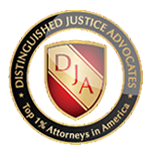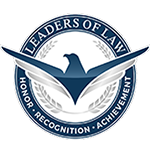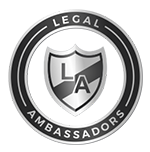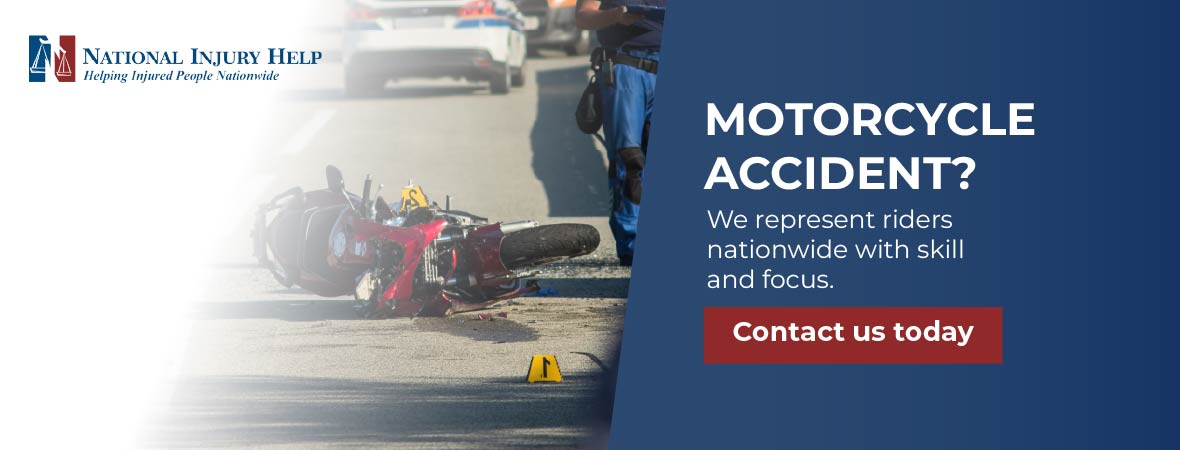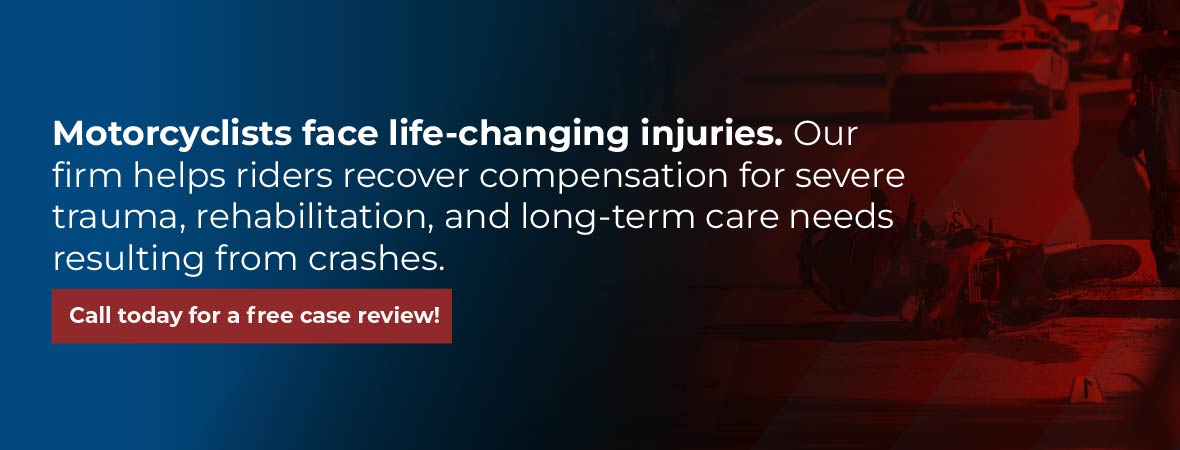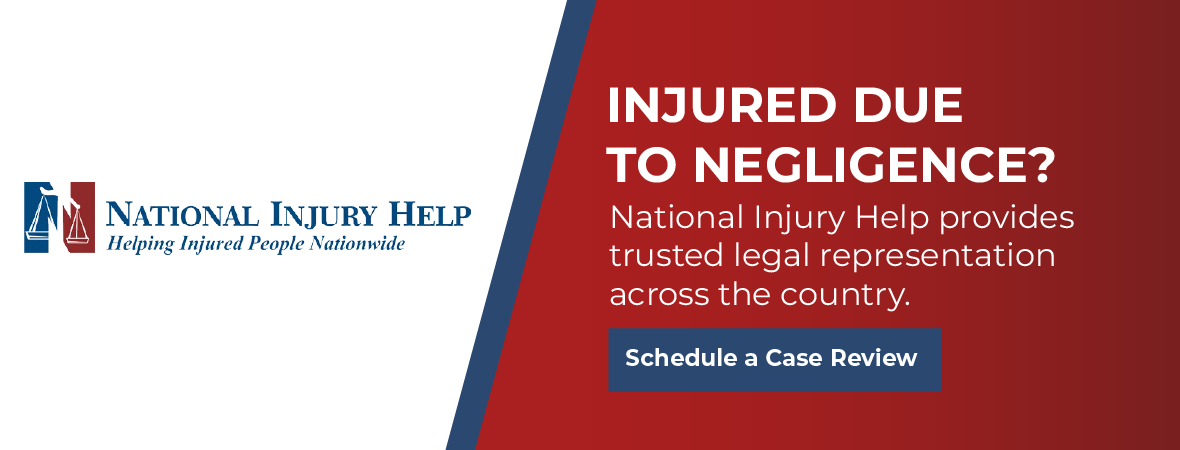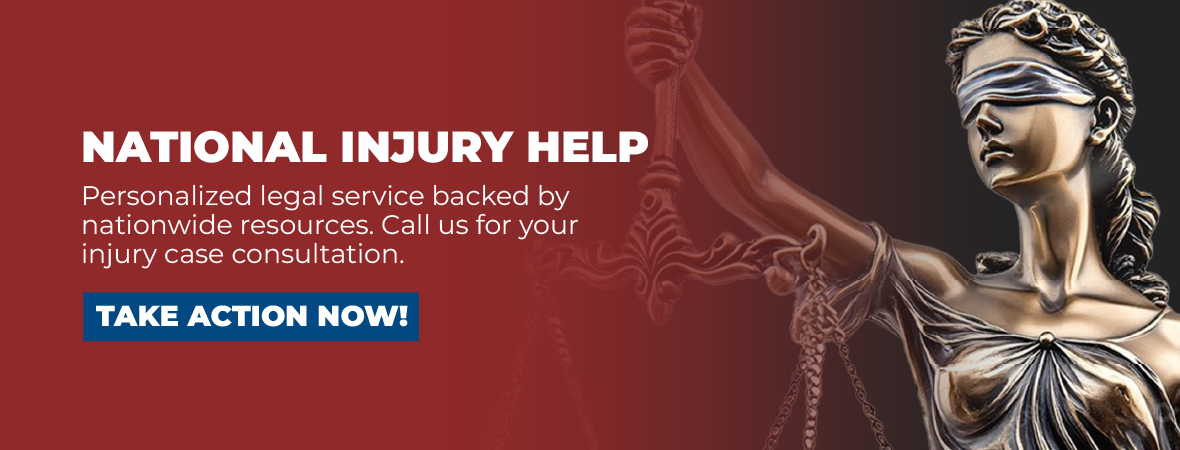Motorcycle accidents often result in serious injuries and high medical bills. Contact National Injury Help today by calling 1-800-214-1010. We are ready to fight for your rights and help you get the compensation you deserve.
According to federal transportation data, over 6,000 motorcyclists died in U.S. traffic crashes in 2022, and more than 200,000 suffered injuries that required emergency care.
Those numbers are not just statistics. They represent fathers, daughters, friends, and neighbors whose lives changed forever. And when a crash happens, injured riders often face a second blow: being blamed, overlooked, or lowballed by insurance companies who label them as reckless.
At National Injury Help, we fight for injured motorcyclists. We understand how crashes happen, what the law requires, and how to stand up for riders’ rights in every state. Whether you ride in California or Connecticut, this guide will walk you through the process of protecting your health, your finances, and your future after a motorcycle crash.
Motorcycle Accident Overview
From the Pacific Coast Highway to the Blue Ridge Parkway, America is filled with breathtaking motorcycle routes. But no matter how scenic the ride, the risks remain high. Motorcycles offer little protection in a crash. Unlike cars, they lack airbags, steel frames, or crumple zones.
Motorcyclists are 28 times more likely to die in a crash compared to people in passenger vehicles. The reasons vary: distracted drivers, road hazards, and increasingly large SUVs all contribute to dangerous conditions.
Riders often face:
- Poor visibility due to weather or headlight issues
- Blind spots created by large vehicles
- Uneven road surfaces or loose gravel
- Sudden lane changes by inattentive drivers
- High-speed impacts in urban traffic or rural curves
Many motorcycle crashes are not the result of reckless riding. They happen during commutes, at intersections, or while obeying traffic laws. These accidents often occur because other drivers fail to see or yield to motorcycles.
Common Causes of Motorcycle Crashes
Below are some of the most common causes of motorcycle accidents in the United States, along with an explanation of how and why they happen.
Driver Distraction
One of the leading causes of motorcycle crashes is distracted driving. Motorcycles are already smaller and less visible than other vehicles. When drivers are not paying full attention, they often overlook bikes completely.
Distractions come in many forms. Texting, scrolling through a playlist, adjusting the GPS, eating, talking to passengers, or simply daydreaming can all pull a driver’s focus from the road. Even a momentary lapse in attention can be enough to miss a motorcycle approaching in the next lane or at an intersection.
At highway speeds, a vehicle travels the length of a football field in just a few seconds. During that time, a distracted driver might drift into a bike’s lane or fail to notice a stoplight change. Because motorcycles respond and move differently from cars, drivers must stay alert and aware of their presence at all times.
Failure to Yield
Failure to yield the right-of-way is another major cause of motorcycle accidents. This often happens when a driver pulls out from a driveway, side street, or parking lot and underestimates how fast an oncoming motorcycle is traveling.
Because motorcycles are small, they can appear farther away than they actually are. This misperception causes many drivers to assume they have enough time to pull out or make a turn, when in fact, they are cutting directly into a motorcycle’s path.
These incidents often happen in residential neighborhoods, at shopping centers, or near schools and workplaces, places with many driveways and side streets. Riders may have little time to react and are often forced to either swerve or brake hard, both of which can lead to a crash.
Left-Turn Accidents
Left-turn accidents are among the most deadly for motorcyclists. They occur when a car making a left-hand turn at an intersection fails to see a motorcycle coming from the opposite direction. The turning vehicle cuts across the rider’s lane, often resulting in a direct, T-bone-style collision.
These crashes are especially dangerous because the rider may be thrown over the handlebars, into the vehicle, or into oncoming traffic. Even at moderate speeds, the impact force can be enough to cause life-altering injuries or death.
Drivers are often found at fault in these cases because they are supposed to yield to oncoming traffic. However, proving fault may require eyewitness accounts, surveillance footage, or crash reconstruction, which is why legal support can be so important after this type of accident.
Unsafe Lane Changes
Changing lanes may seem simple, but when done without care, it can be deadly for a motorcyclist. Drivers who fail to check their mirrors or blind spots can easily collide with a bike that is traveling beside them.
Large vehicles, like SUVs or trucks, make it even harder to see smaller vehicles in adjacent lanes. Motorcycles can quickly disappear from a driver’s view if they are riding just slightly behind the larger vehicle or in a blind spot.
Many riders use lane positioning and reflective gear to make themselves more visible, but visibility is a shared responsibility. Drivers must actively check for motorcycles before switching lanes. When they don’t, a sideswipe or forced run-off from the road is a common result.
Road Hazards
Road conditions that barely affect a car can be extremely dangerous for motorcycles. Uneven pavement, potholes, loose gravel, wet leaves, sand, oil slicks, and standing water all pose serious risks. A small bump or loss of traction can cause a motorcycle to slide, tip over, or lose control.
Construction zones are especially dangerous because they often include abrupt lane shifts, uneven pavement, and exposed metal plates. In some areas, poorly designed or poorly maintained roads may not have sufficient signage to warn riders of upcoming hazards.
Because motorcycles are less stable than four-wheeled vehicles, a minor surface issue can have major consequences. Riders should always be alert to road conditions, but responsibility may fall on a city, county, or construction contractor if the hazard was known and unaddressed.
Speeding
Speeding increases the likelihood and severity of all motor vehicle crashes, and motorcycle accidents are no exception. Whether it is the motorcyclist or another driver who is speeding, high velocity shortens reaction time and increases the force of impact.
For motorcycles, high speeds also reduce stability and increase the difficulty of handling turns or quick maneuvers. A sharp turn taken too fast can cause a rider to slide out. A sudden stop at high speed can throw a rider forward and off the bike.
When other drivers are speeding, they are less likely to see and respond to motorcycles around them. A speeding car may not notice a bike changing lanes or slowing down and may crash into them before having a chance to brake.
Speeding turns otherwise survivable collisions into serious or fatal ones. Broken bones, traumatic brain injuries, and spinal cord damage are all common outcomes of high-speed motorcycle crashes.
Alcohol and Drug Use
Impaired driving is a long-standing problem on American roads. Despite countless public service announcements and strict laws, many drivers continue to get behind the wheel after drinking alcohol or using drugs.
This includes not only illegal substances but also prescription medications and, increasingly, recreational marijuana. While the effects of marijuana may be harder to detect during traffic stops, they can still impair judgment, coordination, and reaction time.
When a driver is impaired, they are far less likely to notice a motorcycle, yield appropriately, or respond to sudden changes on the road. Drunk or high drivers also tend to speed, swerve, and disregard traffic laws, putting everyone around them at risk.
Motorcyclists themselves must also ride sober. Operating a motorcycle under the influence is not only illegal but especially dangerous, given the skill and balance required to ride safely. Impaired riders are at high risk of losing control, even if no other vehicle is involved.
What to Do Immediately After a Motorcycle Crash
Whether your injuries are minor or severe, it is crucial to stay as calm and focused as possible. This guide outlines the key steps every rider should follow immediately after a motorcycle crash to protect their physical well-being, preserve important evidence, and prepare for the legal process that may follow.
1. Call 911 Right Away
The very first thing you should do after a crash is call 911. Even if your injuries seem minor or you believe the accident was not serious, it is essential to involve emergency services. Police and paramedics are trained to manage accident scenes, evaluate injuries, and begin the formal documentation process.
The responding police officer will complete an official accident report, which often includes the names and statements of everyone involved, a description of the scene, initial fault assessments, and any traffic violations. This report becomes a key piece of evidence in both insurance negotiations and any legal proceedings that follow.
Paramedics will assess you and others for injuries. Let them do a full evaluation, even if you think you’re fine. Shock and adrenaline can mask serious injuries. Insist that EMS personnel create a record of your condition, as this medical documentation helps establish a clear timeline that links your injuries to the accident.
2. Move to a Safe Location, If You Can
If you can move and your surroundings are unsafe, try to get yourself to a secure area away from moving traffic. Do not stay in a live lane if you can safely relocate to the shoulder, a median, or a sidewalk. If your motorcycle is blocking traffic and can be moved without further injury or risk, relocate it as well to prevent further incidents.
That said, do not remove your helmet unless absolutely necessary, especially if you suspect a head or neck injury. Movement can make spinal injuries worse. Wait for professional responders to assess you before removing gear.
If you cannot move, try to remain still and visible. Use your hazard lights or ask others to help direct traffic away from the scene until emergency services arrive.
3. Document the Scene Thoroughly
If you are physically able and it is safe to do so, begin collecting evidence as soon as possible. Use your phone or camera to photograph every relevant aspect of the crash. These images help preserve details that may disappear within hours, such as weather conditions or skid marks.
Focus on capturing:
- The damage to your motorcycle and all vehicles involved
- The position of the vehicles immediately after the crash
- Roadway evidence like skid marks, oil spills, broken glass, or vehicle parts
- Traffic signs, lane markings, and nearby intersections
- Street lighting or visibility issues
- Your visible injuries, including cuts, bruises, road rash, or swelling
The goal is to freeze the moment in time so your legal team can later reconstruct what happened.
4. Collect Witness Information
Eyewitnesses can provide valuable third-party accounts of the crash, especially in cases where liability is disputed. Speak to anyone who saw what happened and ask for their name, phone number, and email address. This might include nearby drivers, pedestrians, business owners, or other riders.
When speaking to witnesses, be respectful and thank them for their help. Avoid long conversations or sharing your version of events; just ask them to remain available in case they are needed later.
If you’re unable to speak with witnesses due to your injuries, try to make note of anyone who stayed at the scene and ask someone nearby to assist in collecting their information.
5. Be Careful with Your Words
It’s important to be cooperative with responding officers, but also cautious. Everything you say at the scene may be documented in the police report or remembered by other parties. Avoid making statements that could be misinterpreted as admitting fault or downplaying your injuries.
Do not guess about how fast you were going or speculate about what happened unless you are absolutely certain. Say only what you know to be true. For example, if you’re unsure how the crash occurred, it is perfectly acceptable to say, “I’m not sure. Everything happened so quickly.”
Also, avoid phrases like “I’m okay” or “I’m fine,” even if you are trying to stay polite. These statements can be used later by insurance companies to argue that your injuries were not serious. Let your medical records speak for your condition instead.
6. Seek Immediate Medical Care
Even if you declined emergency transport from the scene, it’s critical that you follow up with a doctor as soon as possible. Some injuries, such as concussions, whiplash, internal bleeding, and soft tissue damage, do not present symptoms right away but can become life-threatening if ignored.
A prompt medical exam also establishes a clear connection between the crash and your injuries. This medical documentation will be an essential part of any insurance claim or legal case. It helps prove that the injuries were directly caused by the accident and not a preexisting condition or unrelated event.
Be honest with your healthcare provider about how the crash occurred, what symptoms you’re experiencing, and how your body feels. Keep records of all follow-up visits, prescribed medications, rehabilitation plans, and any time you miss work due to your injuries.
7. Notify Your Insurance Company, Cautiously
After the crash, you are expected to notify your insurance company that an accident occurred. Be sure to do this within the required time window, which may vary by provider. However, be careful not to go into detail about the crash or your injuries during this initial conversation.
You are not required to give a recorded statement right away, and doing so without legal guidance can be risky. Insurance adjusters are trained to minimize payouts, and they may use your words against you later to challenge liability or the severity of your injuries.
Simply inform the insurer that a crash occurred and that you will be seeking legal advice. Let your attorney handle all further communication. This helps ensure that your rights are protected and that you are not pressured into a quick settlement that fails to reflect the full extent of your damages.
How Motorcycle Law Works Across the United States
Laws differ from state to state, and knowing how they apply can make or break your case.
Helmet Laws Vary by State
Some states require all riders to wear helmets, others only require them for riders under a certain age, and a few have no helmet laws at all. Not wearing a helmet can reduce your compensation if it contributed to your injury, but it does not automatically disqualify your case.
Comparative Fault Rules
In most states, if both the rider and another driver are partly at fault, the court assigns a percentage to each. Your compensation is then reduced by your share of fault.
- Pure Comparative Fault: You can recover damages even if mostly at fault (California, Florida).
- Modified Comparative Fault: You cannot recover if you are 50 or 51 percent responsible (Texas, Colorado).
- Contributory Negligence: Any fault bars recovery (Virginia, Maryland, North Carolina, Alabama, and D.C.).
A knowledgeable motorcycle accident lawyer will argue to reduce your percentage of fault and protect your right to recover.
Statute of Limitations
Each state has a deadline for filing a personal injury lawsuit, usually between one and three years. Waiting too long can bar your claim. If you were injured in a different state from where you live, the state where the crash happened sets the deadline.
Minimum Insurance Limits
Every state sets its own minimum insurance coverage. Many drivers carry only the bare minimum, which often isn’t enough to cover serious injuries. That’s why riders are strongly encouraged to carry uninsured and underinsured motorist (UM/UIM) coverage.
Why You Need a Motorcycle Accident Lawyer
Motorcycle accidents can be life-changing. Riders often suffer serious injuries, spend weeks or months recovering, and face high medical bills and lost income. While drivers of passenger vehicles have the benefit of airbags, seat belts, and steel frames, motorcyclists have very little protection in a crash. This often results in injuries that are far more severe than those in typical car accidents.
To make matters worse, insurance companies are quick to point fingers at motorcyclists. Riders are often stereotyped as reckless or aggressive, even when the crash was clearly caused by another driver. As a result, insurance companies frequently attempt to shift blame, reduce payouts, or deny claims entirely. This is where a motorcycle accident lawyer becomes essential.
At National Injury Help, we understand the unique challenges motorcycle accident victims face. Our legal team is experienced, responsive, and fully committed to helping riders protect their rights and recover the full compensation they are entitled to. Here’s how we help.
Motorcycle Cases Are Different, And That Matters
Unlike typical car accident claims, motorcycle accident cases involve a deeper level of scrutiny and bias. Because motorcycles are smaller and more agile than cars, insurance companies often claim that riders could have avoided the crash, even when they were following the law. Jurors who are unfamiliar with motorcycle dynamics may also need help understanding how and why certain collisions occur.
That’s why having a lawyer who understands both the law and the unique aspects of motorcycle operation is so important. A skilled motorcycle accident attorney will know how to counter unfair biases, explain complex evidence, and present a clear, fact-based story about what really happened.
What Our Motorcycle Accident Lawyers Do At National Injury Help
From the moment you hire us, we get to work building a strong case. Motorcycle accident claims are time-sensitive, and evidence can disappear quickly. Our team takes fast, deliberate steps to secure the facts, prove liability, and demonstrate the full impact of your injuries.
1. Rapid Response and Evidence Collection
The hours and days after a motorcycle crash are critical. Evidence left at the scene, such as skid marks, broken parts, debris, and road conditions, can be lost within hours if not properly documented. That’s why we act immediately.
We send investigators to the crash site to take photographs, collect physical evidence, and document the condition of the roadway. We look for surveillance footage from nearby businesses or traffic cameras, which may show exactly what happened during the moments leading up to the crash.
Our team also interviews eyewitnesses while their memories are still fresh. Witness statements can be incredibly valuable, especially if the other driver denies fault or gives a conflicting version of events.
In some cases, we request vehicle data from the cars or trucks involved in the crash. Many modern vehicles are equipped with electronic control modules, often referred to as black boxes, that store important information like speed, braking, and steering input at the time of the accident. This data can confirm reckless driving or unsafe maneuvers that led to the crash.
2. Accident Reconstruction Experts
When the cause of a motorcycle crash is not immediately clear, we bring in accident reconstruction experts. These professionals use physical evidence, police reports, vehicle damage, and physics-based modeling to recreate the crash and explain exactly how it occurred.
Accident reconstruction is especially useful when:
- The other driver claims you were speeding or swerving.
- There are no reliable witnesses.
- Visibility or road conditions played a role.
- You were hit during a turn or lane change.
Reconstruction helps prove that the other party was responsible and that you did everything reasonably possible to avoid the collision. When presented in court or to an insurance adjuster, this type of expert testimony can carry significant weight.
3. Medical and Financial Documentation
A strong motorcycle accident case includes more than just proving fault. It also requires clearly documenting the full extent of your injuries, your recovery process, and the financial toll the crash has taken on your life.
At National Injury Help, we work closely with your doctors and care providers to gather detailed medical records, including:
- Emergency room and hospital visits
- Surgery and follow-up care
- Physical therapy and rehabilitation
- Medications and assistive devices
- Psychological counseling, if needed
We also project your future medical needs. If your injuries will require long-term treatment, multiple surgeries, or permanent care, we include those future costs in your claim. A fair settlement must account for what you will need years from now, not just what has already been spent.
In addition to medical expenses, we document your lost income, both current and future. If your injuries prevent you from returning to the same job or reduce your ability to work full-time, we calculate the financial losses associated with that change. We may also use vocational experts to support these claims, especially if you must switch careers due to physical limitations.
4. Legal Strategy and Insurance Negotiation
Dealing with insurance companies can be one of the most frustrating parts of a motorcycle accident claim. Adjusters are trained to protect their employer’s bottom line, not to make sure you get what you deserve. They often try to settle quickly, offering low payouts before you even understand the full scope of your injuries.
At National Injury Help, we handle all communication with the insurance companies so you don’t have to. We prepare a detailed demand package that outlines:
- How the crash occurred
- Why was the other driver at fault
- The full scope of your injuries
- The financial impact on your life
- The compensation you are legally entitled to receive
If the insurance company refuses to negotiate fairly, we are fully prepared to take your case to court. We handle all legal filings, trial preparation, and courtroom representation. Insurance companies tend to offer better settlements when they know the other side has a skilled attorney with a strong case and a willingness to litigate.
Types of Compensation an Experienced Motorcycle Accident Lawyer Can Help You Recover
A successful claim can help you move forward financially and emotionally. Here are the common forms of compensation for loss that riders may receive:
- Medical Costs: Hospital bills, surgeries, therapy, medication, and equipment like wheelchairs or braces
- Lost Wages: Income lost during recovery and any long-term impact on your ability to work
- Property Damage: Repairs or replacement of your motorcycle and riding gear
- Pain and Suffering: Physical pain and emotional trauma
- Loss of Enjoyment: Inability to ride, travel, or engage in hobbies
- Loss of Consortium: Strain on marriage or relationships due to the injury
- Punitive Damages: Additional awards if the at-fault party acted with extreme recklessness, such as drunk driving or hit-and-run behavior
An experienced motorbike injury attorney uses a combination of medical records, financial evidence, and personal impact stories to present the strongest case for full and fair recovery.
Choosing the Right Motorcycle Accident Lawyer
The right lawyer can make all the difference. Look for:
- Experience with Motorcycle Cases: Not all personal injury lawyers understand the unique aspects of motorcycle crashes.
- 00Strong Trial History: A proven willingness to take cases to court can pressure insurers to settle fairly.
- Clear Communication: Your lawyer should explain things in plain language and keep you informed throughout the case.
- Nationwide Reach: If you were hurt while traveling, your lawyer should be able to handle cross-state legal issues or work with trusted local counsel.
Interview more than one attorney. Choose the one who listens carefully, answers clearly, and treats you like a person, not a case file.
Frequently Asked Questions
Do I need a lawyer if the other driver was clearly at fault?
Yes. Even if liability seems clear, insurers will often underpay for injuries, lost wages, and future medical care. A motorcycle crash attorney makes sure every damage is accounted for.
What if I was not wearing a helmet?
You can still recover compensation, although the insurance company may argue that your injuries were worse because of it. A lawyer helps reduce or eliminate that argument.
How long does a case take?
Simple claims may settle in a few months. Complex cases with serious injuries or disputed fault can take one to two years, especially if they go to trial.
What if the other driver had no insurance?
If you have uninsured motorist coverage, you can still recover. If not, we explore other legal avenues, including state victim funds or lawsuits against third parties.
Contact a Motorcycle Accident Lawyer Today
If you or someone you love has been injured in a motorcycle crash, do not face the insurance companies alone. At National Injury Help, we fight for riders nationwide. Our team includes experienced motorcycle accident lawyers who know how to win these cases, protect your rights, and recover full compensation for your loss.
You do not pay anything upfront. We work on contingency, which means we only get paid if you win.
Call us at 1 (800) 214-1010 today for your free consultation. Let us take on the legal fight so you can focus on healing and getting back on the road.

